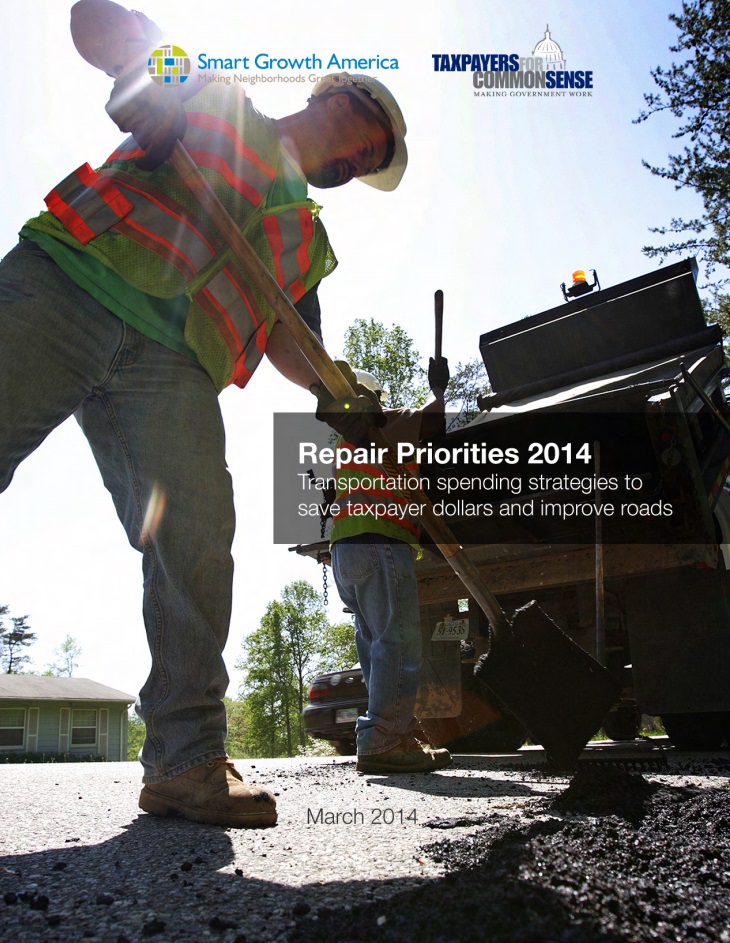
With people driving less and federal largesse not what it used to be, it would make sense for state departments of transportation to shift away from building new roads and expanding existing roads, and move toward maintaining and repairing those that already exist.
But according to Repair Priorities 2014, a recently-released report from Smart Growth America and Taxpayers for Common Sense, most state DOTs “are spending more money building new roads than maintaining the ones they have – despite the fact that roads are crumbling, financial liabilities are mounting and conditions are not improving for America’s drivers.”
There have been some improvements in DOTs’ priorities since SGA’s first release of the report in 2011. Using federal data from 2009 to 2011, the report finds that states spent 55 percent of their road dollars on expansion ($20.4 billion annually) and 45 percent ($16.5 billion annually) on repair.
While New Jersey and New York fared better than the national average (20 percent for expansion in NJ, 23 percent in NY), Connecticut spent slightly more than the national average on new roads, with 56 percent of its funds going toward expansion. This trend will only continue if projects like the I-84 expansion are not scaled back or taken off the table.
Average annual state expenditures on road expansion versus repair, 2009-2011
State % of $ to Road Expansion (of all $ going to expansion and repair)
| Connecticut | 56% |
| New Jersey | 20% |
| New York | 23% |
| Nation (50 states + DC) | 55% |
As you might have guessed, as state DOTs spent more on building new roads, the condition of existing roads has only become worse. In 2011, “Just 37 percent of roads were in good condition that year – down from 41 percent in 2008.” That year, all three states in the region had a higher percentage of roads in poor condition than the nation as a whole, with Connecticut and New Jersey considerably worse. There are many reasons why tri-state roads are in worse condition than other states’ roads. For example, our roads may be older and our climate causes asphalt to crumble faster than it would in warmer parts of the nation. Whatever the reasons, it is clear that DOTs in our region must dedicate more funds to improving the condition of existing roads.
Decisions to spend more money on expansion at the cost of maintenance and repair are problematic for agency finances and taxpayers alike. The report notes that road repairs cost much more than regular road maintenance, as “every $1 spent to keep a road in good condition avoids $6-14 needed later to rebuild the same road once it has deteriorated significantly.” In addition, new roads and new lanes create greater future maintenance needs.
The report offers recommendations geared toward encouraging states to invest more in road maintenance by:
- raising “the public profile of repair projects”
- using “asset management practices”;
- focusing “repair investment on the most heavily used roads”
- setting “aggressive targets for pavement conditions” and
- using “cost-benefit analysis to prioritize road investment”
Federal agencies, too, “can encourage state investments in repair by tying available federal funding to the condition of state highways and modifying current approaches for reporting state road conditions.”
Chart above adapted from Repair Priorities 2014 report.

Damaged roads can be a serious safety hazard and cause many issues for the drivers who travel them daily. Before building new roads, maintaining the ones we already have is good investment. Asphalt is a great way to fix potholes because of its durability.